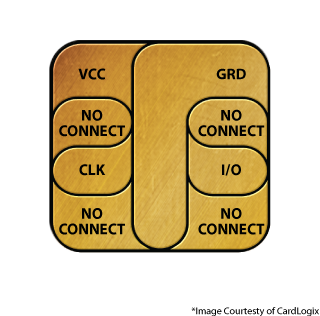A beginner guide to Smart Cards
Smart Cards
Since this has been my current subject of interest I'll post a bit here.
I'll be focusing on a subset of RFID called smart chips, smart cards, SIM cards, etc. A lot of what I say here is taken from what I've been reading, and my next step is to start interacting with them. This is a really quick introduction.
Does this pin out look familiar? Beyond just your phones SIM these are integrated into your credit cards now as well in the US. How weird is that? While the pin out looks the same, they actually very quite heavily with internal technology, looks, etc, but they still use often use T=0 and T=1 protocols to communicate, which if that sounds familiar, are protocols used by GSM.
These only store a small amount of information. It's really important to remember that is their primary function as these chips CAN contain an OS, a CPU, RAM, and applications.
The pin-outs are as follows. It is important to know that of the 8 contacts only 6 are defined (The two that arent are C4 and C8)
C1 Vcc: +5 VDC power supply input (optional use by the card). As we move towards the future we will likely see this change to +3 VDC
C2 RESET: Reset signal, used to reset the card's communications. Either used itself (reset signal supplied from the interface device) or in combination with an interal reset control circuit (optional use by the card). If internal reset is implemented, the voltage supply on Vcc is mandatory. Reset is the signal line that is used to initiate the state of the integrated circuit after power on and it is an integral complex process that I will hopefully get too later.
C3 CLOCK: Provides the card with a clock signal, from which data communications timing is derived. The clock signal is used drive the logic of the IC and is also used as the reference for the serial communications link, the two most common being 3.57 MHz and 4.92 MHz . Which is weird right?! Why not just straight 5MHz? Its because the cheap crystals used to form the clock oscillator. Both frequencies are used by televisions for the color sub carrier frequency. PAL operates at 4.92MHz while the American NTSC standard operates at 3.57 MHz. Remember kids, being cheap is the best thing you can do to make people mistrustful of your actions, intentions, and question your sanity. Be above the influence, or not.
C4 RESERVED AUX1: optionally used for USB interfaces and other uses.
C5 GND: Ground (reference voltage). Vss is the substrate or ground reference voltage against which the Vcc potential is measured.
C6 VPP: Programing voltage input (optional). This contact may be used to supply the voltage required to program or to erase the internal non-volatile memory. The Vpp connector is used for the high voltage signal that is necessary to program the EPROM memory. ISO/IEC 7816-3:1997 designated this as a programming voltage: an input for a higher voltage to program persistent memory (e.g., EEPROM). ISO/IEC 7816-3:2006 designates it SPU, for either standard or proprietary use, as input and/or output.
C7 I/O: Input or Output for serial data (half-duplex) to the integrated circuit inside the card. Used for sending and receiving commands with either T=0 or T=1 protocol. Their is a communication unit between a smart card and a smart card reader called an APDU (Application Protocol Data Unit. There are two categories of APDUs: command APDUs and response APDUs.
C8 RESERVED AUX2: optionally used for USB interfaces and other uses.
Memory
As applications became more advanced we implemented more technology into these chips. Where old telphone cards such as SIM could operate with EEPROM memory (128 - 512 bytes) and the memory control logic. More sophisticated applications will demand ROM, EEPROM, RAM and a CPU depending on the application. It might be easiest to think of the ROM as the operating systems location, the RAM as normal with a device (being where the OS is loaded into), and the EEPROM as a kind of hard drive where you can store data that wont be erased even after we remove power to the card.The control logic is necessary not only for communication protocols but also to offer some protection of the memory against fraudulent use. We can differentiate the different types of integrated circuitry by their content.
- Memory Only
- Memory with security logic
- Memory with CPU
Applications
I hope this is a good introduction to how they work. I go more in depth on my github's cheatsheet, and while you may not be interested on the physical side of things, I am not familiar enough to offer adequate advice on this yet. I can at the very least point you in the right direction. There are two notable operating systems running on cards out there Java Card OS and MULTOS are notable, keep in mind there are others like Microsoft Windows for smart cards (no joke) that may better suit your purposes.



Comments
Post a Comment